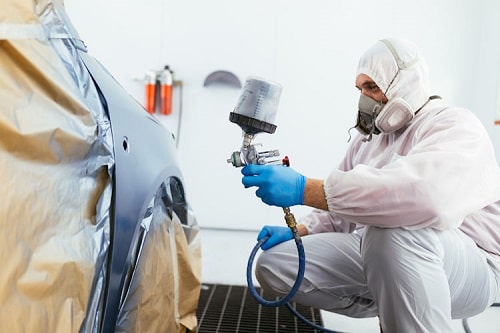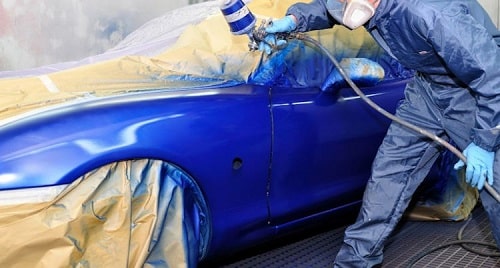 Covering and varnishing the different layers of bodywork paint
Covering and varnishing the different layers of bodywork paint
It was essential to write an article on one of the basic rules of the implementation of a paint, which is the act of covering and varnishing a painting, a primer, or even a varnish by another coat of paint, or any product.
In the instructions for 1C matt base varnish type paint, it is stated that varnish should be applied within 30 minutes after application
► But then what should we do if we have to create decorations, masking, or quite simply if we need more time?
Whatever the method for covering or varnishing the paint, it is absolutely essential to guarantee good adhesion between the different layers: this is the “guarantee of good hold” by covering either “wet on wet” or in sanding.
Here is a tutorial for covering a painting with another paint/varnish
In summary :
Case 1 ► The case of “matt base” paints
It is possible to apply paint or varnish directly to freshly applied paint:
At 20°C, the painter benefits from a time window of 30 minutes to cover without sanding, while ensuring perfect adhesion. This technique is called “wet-on-wet” application and ensures adhesion between coats.
If the painter wants to create decorations, if he wants to apply adhesive masking, or any other action that requires time, then simply let the matte base paint dry for 1 hour, then sand. The painter will then have all the time available before covering with the next paint.
→ Sanding opaque paint is done with abrasive paper
→ Sanding pearlescent, metallic paint, etc., is done with an abrasive sponge
Case 2 ► The case of primers
There are no self-leveling filling primers so that you can paint directly. Sanding two-component primers must be systematic.
When dealing with single-component adhesion primers, then it is possible to use the 'wet on wet' coating technique, as these are very thin primers. Be careful, 1C adhesion primers dry very quickly and you often have to start painting within 5 or 10 minutes maximum.
This is the case for plastic primers or primers for metals.
Case 3 ► The case of direct gloss lacquers and varnishes
For this type of product, it is imperative to wait for complete drying before being able to sand, then apply new layers of paint or varnish.
The technique to cover or varnish a painting
This is one of the essential points in the practice of spray painting, in the field of industry, equipment or bodywork. The different paint systems always have several layers and several stages. It is indeed rare for a painting to be done in a single layer and with a single product; that is to say, in a way, a single product that is at the same time, the primer, the color and the finish.
It is in the technical data sheet and the instructions of the product that we find this term of covering the paint, often accompanied by another discreet but essential term : "the time interval".
To give an example of what is the covering of a paint, we can take the case of a primer: this base coat must necessarily be followed by a paint. If we take the field of automotive paint as an example, the paint is necessarily covered with a clearcoat.
So how should these different products be coated ? With what preparation ? And when ? What do you risk if you apply one product directly to another without taking into account the specific instructions for that product ?
The time interval separates the application of the layers in time. This is an important parameter that depends on each type of paint. Drying is itself a function of the ambient temperature, the thickness and the time that elapses.
The different layers of a painting must be superimposed on each other in such a way that they can adhere to each other. All paints, primers and also varnishes have a superficial and through-drying time. From the moment the product has become dry to the touch, that is to say on its surface, then in general, it is no longer possible to cling to it properly for the product which comes to rest on top .
The three covering or varnishing techniques for a painting
There are therefore several ways to superimpose two different products :
For the first technique, we use the term "wet on wet". It is a professional term for the rapid, no-sanding overcoating of a paint or clear coat over another paint, without sanding, during the short time after the basecoat has been applied, where it is not yet dry on the surface. This process is effective and ensures excellent cohesion of the two layers by "melting" the solvents and the polymers.
After a certain period of time, the base paint has dried on the surface and there is no longer any way to cling to it, while guaranteeing guaranteed adhesion over time. The longer we wait from this moment of being "dry to the touch", the less the overpaint will be able to adhere properly.
The second type of preparation to obtain adhesion is sanding. Sanding a surface creates micro scratches in which the paint, the varnish will be able to secure.
When you want to work without haste, or when you are working on a large surface, or when you want to create decorations, the installation of adhesive logos, then you have to choose this technique.
Sanding can only be done when the paint surface is dry. When doing a light sanding, it is not necessary to wait until the paint is completely dry. It is possible to sand with water to avoid friction and overheating on paints that are still too soft.
Once the base coat has been sanded, there is plenty of time to cover with the next paint. It is in no way a question of stripping, but simply of superficial sanding to promote adhesion.
To carry out a coating in the rules of the art, it is necessary to respect the recommendations for use of the product : for example, when the technical sheet of a clearcoat recommends the application on a paint, with a sanding paper to sand P500, then it is not correct to sand with P1000 sandpaper. There are even some very thick clearcoats, and in particular some UHS, which recommend sanding with P320.
When the rules of covering have not been observed, then the risk of detachment is inevitable. Detachment can occur spontaneously after a variable period of time, which can go up to several months or years in certain cases, or in certain cases of collision, shock or scratch, which will allow the layer to open. superficial, to which will follow the detachment. It is common for those who make decorations with masking, adhesive stencils and scalpel cutouts, to get detachments when removing the adhesives.
Often, we do not know the cause of the defect and we can incriminate the product. This is proof of ignorance of the technical application recommendations. One thing that is certain is that if you want to avoid all kinds of problems with poor adhesion, you just have to do a correct sanding, because with sanding, detachment is simply impossible.
In the case of clearcoats, it is always possible to cover a varnish with another varnish, always respecting the rule of sanding. No, it is not possible to apply one polish over another polish wet-on-wet, as this will affect the shine.
There is a question that comes up frequently, it is that of the covering of a primer: no it is not possible, or not recommended, to directly cover a primer with paint, without having practiced sanding. Even though there are supposedly self-leveling primers out there, the truth is that you still need to sand over a primer. wet, or sanding. This technique inspired by the industrial world, in particular plastic and glass, makes it possible to apply a product on a hard and dry glossy layer while having good adhesion. This involves the use of a flame on the surface of the glossy paint, which will allow a so-called "covalent" grip. We have already written an article about this effective and little known technique, which allows for example to apply a layer of matte clearcoat on an area of glossy clearcoat without sanding.
 The art of varnishing
The art of varnishing
The application of varnish or lacquer is a technique that dates back more than 2000 years. There are a variety of clearcoats and the art of varnishing for cars, motorcycles, bicycles and decoration is declined according to the many practices and trades. In industry and bodywork, but also in art, sculpture, shop windows or even bottling, varnishes are used to lacquer base paints.
Many paints cannot in fact be directly glossy, because they are pearlescent, metallic and for these reasons they are usually thin, matt or satin. Varnishing is a technique or an art, difficult to master because it crowns a job well done and it is never easy to achieve.
How to avoid orange peel in paint ?
This term orange peel applies to a dry clearcoat. It is generally used in the world of body painting. This is a common fault encountered by many amateur users. We have therefore written an article that explains how to avoid orange peel in paint during application, but also how to correct this defect on a finished clearcoat.
Orange peel is an easy defect to remove and c It is also a defect whose cause is easy to identify. We tell you in this article everything that you absolutely cannot miss.
General techniques for applying paints and lacquers
Drying paint and firing
Specific techniques applied to painting



















































































